
Q1. What is the Hubble 🔭 Telescope?
Ans. The Hubble Telescope is a space-based observatory launched in 1990 by NASA and ESA.
Q2. What is a ✨ supernova?
Ans. A supernova occurs when a massive star runs out of fuel and explodes.
Q3. What did Hubble 🥵 recently observe?
Ans. Hubble captured a rare view of a supernova explosion in a distant galaxy.
Q4. Why is this 🔎 discovery special?
Ans. Because Hubble recorded the supernova in different stages, which is highly valuable for astronomers.
Q5. Why do 🔬 scientists study supernovae?
Ans. Supernovae help scientists understand the expansion of the universe and the life cycle of stars.
Q6. What elements are formed in a 🎇supernova?
Ans. Heavy elements like gold, silver, and iron are formed during supernova explosions.
Q7. Can a supernova happen in our 🌌galaxy?
Ans. Yes, but it’s very rare. The last one visible to Earth was in 1604.
Q8. What new 🆕 information did Hubble provide?
Ans. For the first time, scientists observed a supernova explosion in three distinct phases in real-time.
Q9. Does a supernova affect 🌍 Earth?
Ans. Only if it happens very close, but the one Hubble observed is millions of light-years away.
Q10. What is the future 🌝 benefit of this discovery?
Ans. It will help researchers understand the universe’s age, dark energy, and the birth and death of stars.